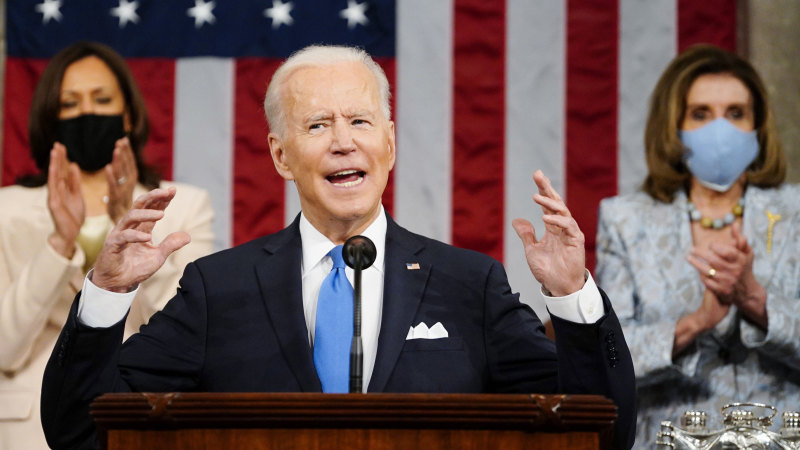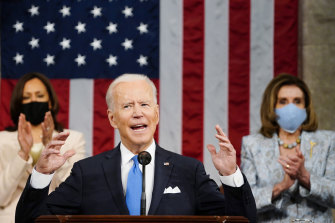President Joe Biden and his economic team are pushing their most detailed case yet for trillions of dollars in new federal spending to rebuild public investment in workers, research and physical infrastructure, focusing on long-term ingredients of economic growth and equality even as the current recovery from recession shows signs of distress.
In a new document from the White House Council of Economic Advisers, obtained by The New York Times, Biden’s team casts his $US4 trillion economic agenda as a way to correct decades of tax-cutting policies that have failed to boost the middle class. Instead, the administration is pushing a rebuilding of public investment, like infrastructure, research and education, as the best way to fuel economic growth and improve families’ lives.
The document shows the Biden team is focusing on long-term economic policy at a time when conservatives have ramped up criticism of the president over slowing job growth and accelerating inflation.Credit:AP
The document provides a deeper economic backbone for arguments that Biden has made publicly and privately to sell his plans to lawmakers, including his expected comments to a group of Republican senators he has invited to the White House on Thursday to negotiate over an infrastructure package.
It also reflects the administration’s longer-term thinking on economic policy at a time when conservatives have ramped up criticism of the president over slowing job growth and accelerating inflation. Republicans continue to insist that tax cuts, particularly for business, are the key to economic competitiveness and middle-class prosperity. They have refused to negotiate any changes to their party’s signature 2017 tax law as part of an infrastructure agreement, even as they concede some need for a limited version of the new public investments Biden is calling for.
Administration officials express confidence that recent price surges in used cars, airfare and other sectors of the economy will prove temporary and that job growth will speed up again as more working-age Americans are vaccinated against COVID-19 and regain access to child care during work hours. They say Biden’s $US1.9 trillion economic aid package, the “American Rescue Plan,” which he signed in March, will lift job growth in the months to come — and that it is appropriate for the president to look past the current crisis and push efforts to strengthen the economy long-term.
The two halves of Biden’s $US4 trillion agenda, the “American Jobs Plan” and the “American Families Plan,” are premised on the economy returning to a low rate of unemployment where essentially every American who wants to work is able to find a job, Cecilia Rouse, who leads the Council of Economic Advisers, said in an interview.
“The American Rescue Plan was rescue,” Rouse said. “It was meant as stimulus as we work through this, you know, hopefully once-in-a-century, if not longer, pandemic. The American Jobs Plan, American Families Plan are saying, look, that’s behind us, but we knew going into the pandemic that there were structural problems in our country and in our economy.”
Biden’s plans would raise taxes on high earners and corporations in order to fund new federal spending on physical infrastructure, care for children and older Americans, expanded access to education, an accelerated transition to low-carbon energy and more.
Those efforts “reflect the empirical evidence that a strong economy depends on a solid foundation of public investment, and that investments in workers, families, and communities can pay off for decades to come,” Biden’s advisers wrote. “These plans are not emergency legislation, they address long-standing challenges.”
The five-page brief focuses on arguments about what drives productivity, wage growth, innovation and equity in the economy. All are issues that predate the coronavirus recession and recovery — and which Democrats in particular have pledged for years to address.
The US economic recovery is showing signs of slowing. Credit:AP
It also recounts what it calls the federal government’s underinvestment in policies that help educate children and adults, facilitate the development of new technologies and industries and support parents so that they are able to work and earn more. It singles out the wave of fast-developed COVID-19 vaccines from Pfizer and Moderna, which grew out of publicly funded research, as an example of public investments yielding private-sector innovation.
“Those started with ideas that were funded by the public sector decades ago,” Rouse said. “And then the private sector built on top of that, so it’s really the private sector needs to work with the public sector. We are all very grateful that the public sector was willing to take that risk, and it didn’t pay off right away.
“In many ways, the federal government should be patient,” she said. “We are a kind of entity; we should be patient. So I’m not saying we have to wait a million years for something to pay off, but we don’t need to have the kind of immediate payoff that a private company might need to see.”
The New York Times
Business Briefing
Start the day with major stories, exclusive coverage and expert opinion from our leading business journalists delivered to your inbox. Sign up here.
Most Viewed in Business
From our partners
Source: Read Full Article


